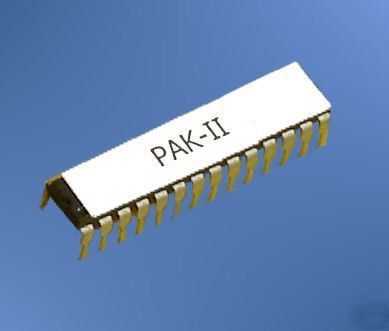Repair Parts -- new and used -- moderated newsgroup for trading > Repair Electronics
> Wave Guides
> Add advanced floating point math to your mpu
Add advanced floating point math to your mpu
For Sale: Add advanced floating point math to your mpu
Subject Add advanced floating point math to your mpu
Ad is submitted by poster:
What is 10 divided by 3? Your Basic Stamp thinks the answer is 3! Most other microcontrollers can't do any better because they all use integer math. Sometimes you can get by with integer math, but sometimes you need precision floating point results. That's where the PAK-II can help.
AWC is pleased to introduce a new member of its Pak series of coprocessors: the PAK-II Math Coprocessor. This easy to use chip augments your Stamp or other microcontroller with full 32-bit floating point math. The PAK-II is a standard 28-pin IC (.3 inch spacing) that can interface with your microcontroller using only 2 pins.
Consumes very few processor resources
Handles 32-bit floating point numbers
Robust, speed-independent serial interface - only 2 pins required
Can connect multiple Stamp Paks to the same 2 pins using an enable pin for each device
Can work with IEEE754 format numbers (same format used by the PC)
Stamp II users can use ShiftIn and ShiftOut
Built-in function for converting floating point to ASCII
Synchronous operation - read results when you are ready for them. No blocking and no interrupts required.
Fast 20MHz operation speed (ceramic resonator included) Worst case add time is about 55uS. Worst case divide is about 190uS.
Bonus 16 I/O pins you can control (if you only use 2 pins to talk to the PAK-II it is like getting 14 free I/O pins)
Support for roots, exponentiation, sine, cosine, tangent, common and natural logarithms, and antilogs.
With the PAK-II you'll receive the IC, a ceramic resonator, a manual, and a software disk. The disk contains examples, and a program to convert between decimal numbers to the Pak-II and IEEE754 formats. The manual explains the communications protocol in detail, the connections required to the chip, and the commands you can use.
Read the manuals online in pdf format: PAK-II. You can also read some technical notes and example applications in the Document Library.
The PAK-II includes: 16 I/O pins, log, ln, 10**x, e**x, sin, cos, tan, sqrt, x**y, and root functions. You can store 24 temporary results. Code is compatible with the PAK-I.
The PAK-II includes the powerful POLY command. With this command, you can store a set of coefficients in the PAKs registers and then issue a single command to compute a polynomial with those coefficients.
For example, suppose you need to compute 5X-3 (this is the classic y=mX+b equation). You could load register 1 with 5 and register 2 with -3 (using the STO command). Then simply execute the POLY command to computer X=5X-3.
Suppose you wanted to compute .5X**3 + 3X**2 - 6.1X + .33 - then you could store .5, 3, 6.1, and .33 in any four consecutive registers and issue a POLY command to make the required calculations. The PAK-II can automatically compute polynomials up to order 8 using this command.
The PAK-II is a 28-pin .3" package. Although the PAKs are especially easy to use with the Stamp, you can use them with any microcontroller. Here's some example code for the PIC and the Ubicom SX.
repair--parts.com bears NO responsibility for this ad. Please report ads that do not follow our
rules (on front page).
Posted By: Curtis Washington
Contact: curtis_washington@repair--parts.com (Curtis Washington) (this is a temporary forwarding address).

